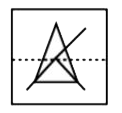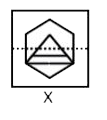A solid transparent sphere has a small, opaque dot at its center. When observed from outside the apparent postion of the dot will be
Closer to the eye than its actual position
The same as its actual position
Farther away from the eye than its actual position
Independent of the refractive index of the sphere
The correct Answer is:B:D
To determine the apparent position of a small opaque dot located at the center of a solid transparent sphere when observed from outside, we can follow these steps:
Step 1: Understand the Setup
We have a solid transparent sphere with a small opaque dot at its center. The observer is looking at the sphere from outside.
Step 2: Identify the Light Rays
When light rays travel from the opaque dot, they will pass through the transparent material of the sphere. We need to consider how these rays behave as they encounter the sphere's surface.
Step 3: Apply the Law of Refraction
According to the law of refraction (Snell's Law), when light passes from one medium to another, it bends. However, if the light ray strikes the surface of the sphere at the normal (perpendicular), it will not bend. This is known as normal incidence.
Step 4: Analyze the Path of Light Rays
Since the dot is at the center of the sphere, light rays emitted from the dot will strike the surface of the sphere at the normal. Therefore, these rays will continue in a straight line without bending.
Step 5: Determine the Apparent Position
Because the light rays do not bend when they exit the sphere, the observer will see the dot at its actual position, which is at the center of the sphere.
Step 6: Conclusion
The apparent position of the opaque dot, when viewed from outside the sphere, will be at the same position as its actual position.
Final Answer
The apparent position of the dot will be at the same position as its actual position.
---
We have a solid transparent sphere with a small opaque dot at its center. The observer is looking at the sphere from outside.
When light rays travel from the opaque dot, they will pass through the transparent material of the sphere. We need to consider how these rays behave as they encounter the sphere's surface.
According to the law of refraction (Snell's Law), when light passes from one medium to another, it bends. However, if the light ray strikes the surface of the sphere at the normal (perpendicular), it will not bend. This is known as normal incidence.
Since the dot is at the center of the sphere, light rays emitted from the dot will strike the surface of the sphere at the normal. Therefore, these rays will continue in a straight line without bending.
Because the light rays do not bend when they exit the sphere, the observer will see the dot at its actual position, which is at the center of the sphere.
The apparent position of the opaque dot, when viewed from outside the sphere, will be at the same position as its actual position.
The apparent position of the dot will be at the same position as its actual position.
Topper's Solved these Questions
- GEOMETRICAL OPTICS : REFRACTIONBOOK - RESNICK AND HALLIDAYCHAPTER - GEOMETRICAL OPTICS : REFRACTIONEXERCISE - Practice questions(More than one correct choice type)
14 Videos
- GEOMETRICAL OPTICS : REFRACTIONBOOK - RESNICK AND HALLIDAYCHAPTER - GEOMETRICAL OPTICS : REFRACTIONEXERCISE - Practice questions(Linked Comprehension)
2 Videos
- GEOMETRICAL OPTICS : REFRACTIONBOOK - RESNICK AND HALLIDAYCHAPTER - GEOMETRICAL OPTICS : REFRACTIONEXERCISE - Problems
44 Videos
- GEOMETRICAL OPTICS : REFLECTION BOOK - RESNICK AND HALLIDAYCHAPTER - GEOMETRICAL OPTICS : REFLECTION EXERCISE - PRACTICE QUESTIONS (Integer Type)
3 Videos
- GRAVITATIONBOOK - RESNICK AND HALLIDAYCHAPTER - GRAVITATIONEXERCISE - PRACTICE QUESTIONS (INTEGER TYPE)
4 Videos
Similar Questions
A hollow sphere of glass of inner and outer radii R and 2R respectively has a small mark on its inner surface. This mark is observed from a point outside the sphere such that the centre of the sphere lies in between. Prove that the mark will appear nearer than it really it, by a distance (μ−1)(R)/(3μ−1)
View SolutionA square transparent sheet with a pattern is given. How will the pattern appear when the transparent sheet is folded along the dotted line?

View Solution
Knowledge Check
A solid, transparent sphere has a small, opaque dot at its center. When observed from outside, the apparent position of the dot will be
ACloser to the eye than its actual positionBFarther away from the eye than its actual positionCThe same as its acutal positionDIndependent of the refractive index of the sphereA solid transparent sphere made of glass (R.I.=μ>1) has a small, opaque dot at its centre. When observed from outside, apparent position of dot will be
Acloser to eye than its actual positionBfarther from eye than its actual positionCsame as its actual positionDindependent of refractive index of the sphereThere is a solid transparent sphere with a point object embedded at its centre. Apparent location of the point object will be
Acloser to eye than its actual locationBfarther away from eye than its actual locationCsame as its actual locationDsame for any material
A square transparent sheet with a pattern is given. How will the pattern appear when the transparent sheet is folded along the dotted line?

View SolutionA square transparent sheet with a pattern is given. How will the pattern appear when the transparent sheet is folded along the dotted line?

View SolutionA square transparent sheet with a pattern is given. How will the pattern appear when the transparent sheet is folded along the dotted line ?

View SolutionA square transparent sheet with a pattern is given. How will the pattern appear when the transparent sheet is folded along the dotted line?

View SolutionA square transparent sheet with a pattern is given. How will the pattern appear when the transparent sheet is folded along the dotted line?

View Solution
